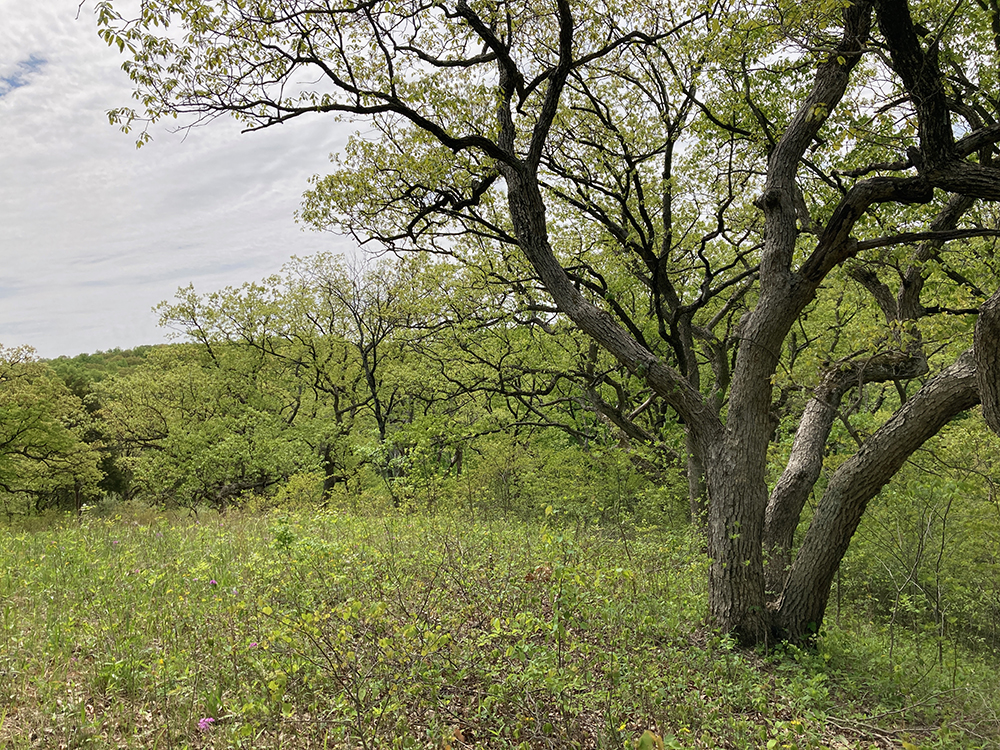
Each trunk of this Chinquapin Oak at Camp Wokanda in Peoria County is probably more than 375 years old. (MIKE MILLER)

MIKE MILLER
Way back in forestry class, I learned that a good forestry practice was to leave some old trees standing when harvesting timber. Our forestry professor, Dr. Jay Cravens, used to say, “Make sure you leave some of the old trees so the forest can remember who it is.” As a young college student, I didn’t really understand the meaning — or importance — of that statement.
Some 40-plus years later, those words have much more meaning. Having grown up here in central Illinois, I’ve got to know many of these “old trees.” They stand as craggy, weather-beaten sentinels of the forest, surrounded by young, hale trees in the prime of their lives. Many of these old trees are well over 300 years old, and some are likely much older than that. One Chinquapin Oak at Camp Wokanda has a several-branched trunk. Each of the trunks is over 375 years old, and likely they are all ancient sprouts from an older stump. The root system could be hundreds of years older. Another old White Oak stands in Singing Woods, overlooking the Illinois River valley. Its branches sprawl out 50 feet from the 6-foot diameter trunk. It is a tree that was alive when the Frenchman, Henri de Tonti, paddled by on the Illinois River in 1691.
These old trees are very far and few between. The climate of Illinois is tough on trees. If you live long enough, there is a good chance you will experience an ice storm, windstorm, or wildfire that is resolved to turn you into dust. Add to that the number of humans that cut trees for wood, or diseases and insect infestations that can kill trees, it is a wonder that there are any trees as old as these survivors. They make up a very small percentage of the trees in the forest. In our local forests, it is likely that trees more than 300 years old make up only .01% of our woodlands. Even though they are rare, we shouldn’t underestimate the importance that these ancient trees play on the ecology of the forest.
These trees have survived a lot. They have seen it all, and somehow, they persist. Is it genetics, chance, location, or just plain luck? Whatever it is, these survivors span centuries of existence and pass on their ability to survive to another generation. The fact they have lived so long shows that they possess some degree of genetic resilience. They have a “knowledge” of what it takes to survive here, and a “memory” of the challenges that their offspring can face moving forward.
Recent research published in the February 2022 edition of the journal Nature Plants dives into the science behind tree longevity and the important role that these trees play in the health and resilience of the forest. Chief author Charles Cannon, Ph.D., is the Director of Tree Science at the Morton Arboretum in Lisle. He states, “These life-history ‘lottery’ winners are vital to long-term forest adaptive capacity and provide invaluable data about environmental history and individual longevity. Old and ancient trees cannot be replaced through restoration or regeneration for many centuries. They must be protected to preserve their invaluable diversity.”
After 40-plus years of wandering around our local woodlands, I have met many an ancient tree. I have also seen many of these ancient trees meet their end. Most are uprooted by severe winds. Some finally succumb to disease and simply don’t leaf-out after a cold winter. They stand as silent monuments for many years to come. Given our comparatively short, human lifespans, it is sad, and poignant, when you experience the loss of these ancient trees. Luckily, here in central Illinois, there are still protected forests where these ancient trees can survive. It took me many years to understand what my forestry professor meant by “leaving the old trees so the forest could remember who it is.”

Recent Comments